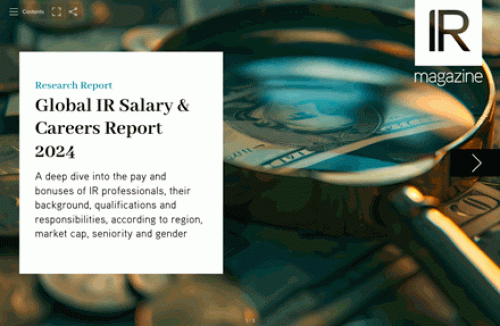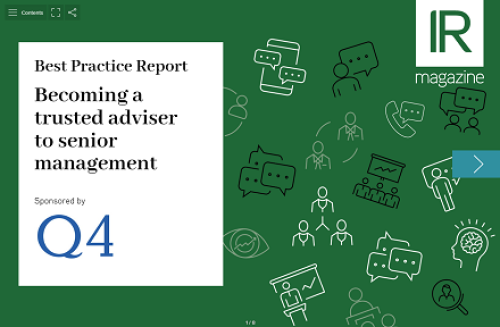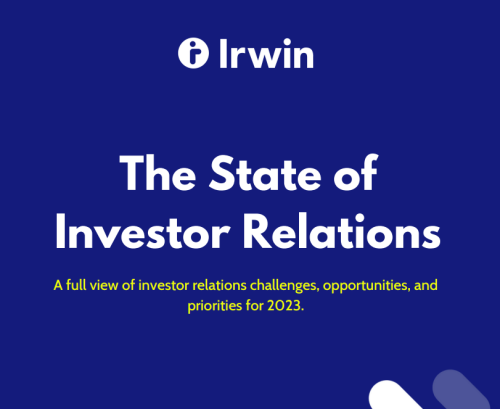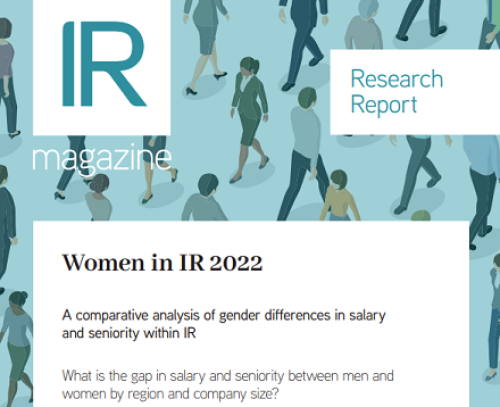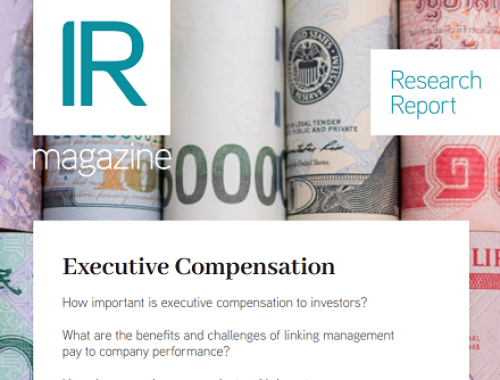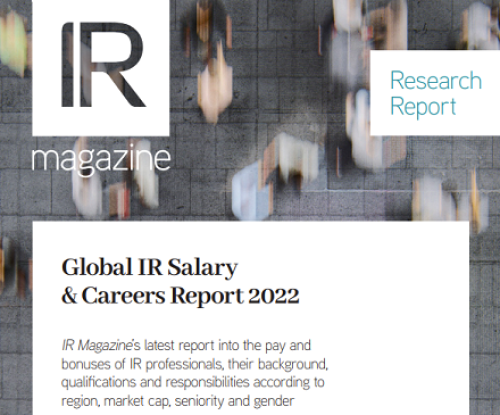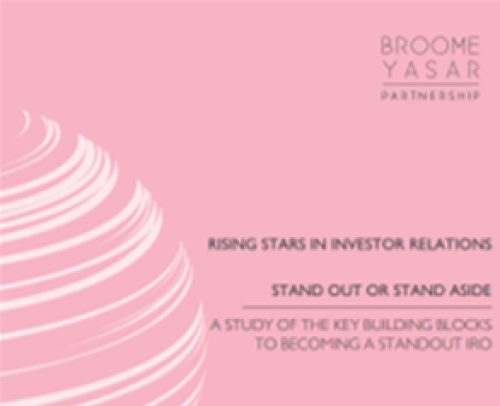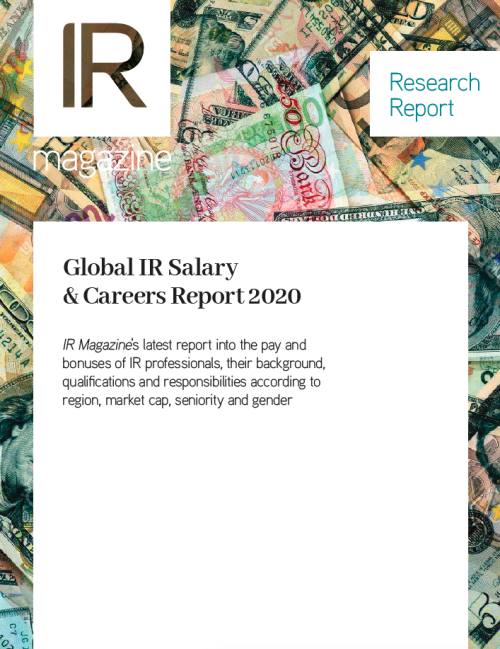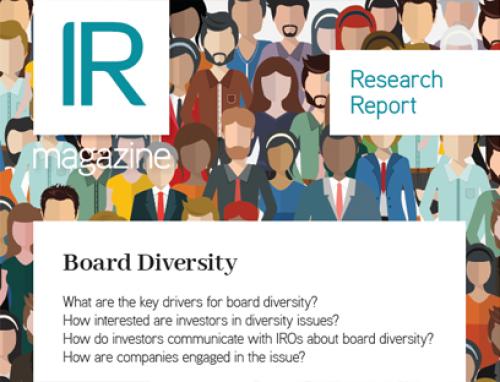Spring is here and in addition to enjoying the daffodils and ending the results season, we also mark International Women’s Day (IWD). This is a variation on what AI suggested, which was: ‘Just as spring heralds the arrival of new beginnings and growth, IWD celebrates the achievements, contributions and resilience of women worldwide’. Hard to argue with that.
When I was asked to write this column, I was excited to see strong evidence of the progress made since the last time I voiced my views on this subject in a pre-Covid world. After all, much has been talked about, written and researched on the benefits of having a diverse workforce. We’ve seen promising targets and convincing reporting.
My excitement was short-lived, however, after I read a summary of the soon-to-be-published research on careers and pay in IR from IR Magazine. Putting pay aside, the IR industry has made sluggish progress in gender diversity, with the proportion of female IR chiefs actually down to 34 percent in 2023 from 41 percent the year before.
Still, the optimist in me points out that the direction of travel is broadly the right one, though the realist in me is frustrated with the speed of developments.
Head of…
As an industry, we seem to have little issue in attracting the right talent, but are incapable of effectively nurturing, retaining and promoting it. As IR Magazine’s research notes, women seem to fizzle away the closer they get to ‘head of’ positions and then almost evaporate from these positions the higher they climb up the market-cap scale.
This presents two questions: why do so few women stay and progress to the top roles and what can be done about it? Logic dictates that once you understand the reasons, the solutions follow. This is, of course, easier said than done.
Personally, I have been fortunate to work with wonderful, diverse teams in my career, so I turned to incredibly talented and highly experienced women in the gender-neutral IRO Coffee Break group – a network of senior IROs I founded four years ago – to get their views and thoughts, mixed in with my own experiences.
A dysfunctional eco-system
IR is a unique industry and part of a multi-disciplined ecosystem, so it’s worth stepping back and looking closely at what is happening to diversity here.
Internally, we are hired and work closely with the C-suite. Various targets have been set to increase female representation at the board level. Personally, I remain opposed to gender diversity targets as I prefer to be hired and promoted for the value I bring to the table, not for my gender. But if this is the necessary step to achieving the ultimate goal of equality, I can go with it. After all, as someone said, ‘What gets measured, gets managed’.
The latest report from FTSE Women Leaders notes that ‘representation of women on FTSE 350 boards has increased beyond the 40 percent target two years ahead of the plan’. Hurrah, I hear some say. Dig deeper, however, and you see this figure is achieved somewhat artificially through non-executive director (NED) appointments rather than executive roles.
The report also looks at female representation across two levels of leadership below the board – and this is where the real picture is clearer: there has been only a 1 percentage-point improvement on last year across the FTSE 250 to 33.9 percent female representation, while female CEO progress across the FTSE 350 remains flat. The number of women finance directors in the FTSE 350 ‘has reduced’, though only slightly (to 48 from 50).
On the other side of the equation, we have our ‘customers’ – the investors and analysts we talk to on a daily basis. Statistics from the Citywire database in September 2023 show that only 12.1 percent of portfolio managers are female – an increase of 0.1 percent on the year before. How many female fund managers did you meet on your last roadshow? I have met four in my 20+ year career.
Perceived trust and unconscious bias
Internally, our reporting lines are mainly to the CFO or, to a lesser degree, the CEO. These roles are predominately held by men. And men, according to various studies, hire people like them, which unconsciously links to perceived trust. CFOs tend to feel ‘comfortable’ working with someone who, as one recruiter told me ‘speaks their language’ – essentially someone from a finance, investment banking or equity research background.
As business context is changing with the rise of reputational issues, the makeup of society, the expectations of Gen Z, the rise of the employee voice and public movement interventions – among other factors mentioned in the FTSE report – there is hope for change, as an increasing number of progressive companies view diverse teams as a leadership prerequisite.
But too many are still resistant to change and slow to act. I still see mandates in the market for a male head of IR with a background in investment banking (a strategic thinker) and a female number two (a steady pair of hands to support the head of IR) simply to satisfy a CFO’s need for comfort. To balance this point, I must acknowledge increasing searches for female heads of IR, predominately driven by the need to improve diversity KPIs.
Much has been said about the increasing investor focus on diversity as a driver of success in the long term, but is there an unconscious bias against female leaders? A study by the London Business School finds that ‘equity analysts are more likely to downgrade stock recommendations when companies appoint a female chief, despite a complete lack of evidence that these newly appointed women underperform.’ Other research has shown that female executives face more aggressive questioning on the earnings call.
Definition of success – and the impact on a female pipeline
Women view success differently from men. I am generalizing here but, with so many other demands on women outside of work, having a work-life balance might be more important than having an executive job title. As we progress through our careers with the drive and determination to ‘make it’, jumping through the many corporate and personal hurdles life throws at us, we reach mid-life – with its own challenges – and perhaps start questioning whether the top job is actually worth the effort.
For some, this spells the end of corporate life. Losing highly experienced women in their forties and fifties inevitably drains the talent pool as well as the pipeline for future female leaders.
So what can we do about it? The first ‘why’ requires a significant shift in corporate culture to ensure that diversity thrives. As with any change, this takes time, so we need to be in it for the long haul.
Although I don’t see us reaching the equality ‘destination’ in my professional life, I am very hopeful that my daughters’ Alpha generation will reap the benefits of the multiple initiatives being implemented by an increasing number of companies to create that illusive gender balance. As forward-thinking Gen Z leaders come through the ranks, I believe the speed of change will accelerate across the whole eco-system.
The second ‘why’ is a tricky one though, as it is something quite personal. My view is to focus on what you can control. If your drive, professional fulfilment, experience and determination are there to take you to the next level, then embrace it. Be your own confident CEO.
Top tips for driving female representation up the career ladder
- Be honest with yourself and clear on what you really want professionally and your motivation for it, as well as on what’s holding you back.
- Build your inner ‘cheerleader’ network wisely from different backgrounds and experiences (internal and external). Go beyond your industry and/or your level. My cheerleaders come not only from IR, but also from legal, marketing, pharmaceutical and other worlds. They give me a more rounded perspective on what is possible and put me straight if I surrender to imposter syndrome, something no one is immune to.
- Be visible and curate your professional network: fund managers, equity research, brokers, investment bankers, NEDs, and so on. This isn’t just about collecting LinkedIn connections, but also about proactively maintaining relationships, especially after you change companies or sector. As with any relationship, this is a two-way process, so all you can do is ensure your way is open. We can also put pressure on our professional bodies to do more work with other organizations in the eco-system. For example, as CFOs are the ones making decisions on IR recruitment, let’s engage with their professional body and build links, connections and awareness.
- Give, give, give. Give your time to the younger generation coming to IR. Give your support and be an advocate for growing talent. It will help you grow as a leader. If you made it to the top, offer empathy to those who are still on the journey and don’t shy away from mentoring. I personally found it very difficult to find senior female mentors who, despite preaching mentorship, prefer not to do it themselves.
- Be vocal about both your own career aspirations and the changes that need to be made internally for female talent to thrive.
- Fear not! If you feel you have reached the end of the professional development road within your company or find the culture and support limiting your progress, don’t be afraid to move on. We are living in a changing world with more companies waking up to a need for evolution, so find one that values your experience and what you bring to the table.

